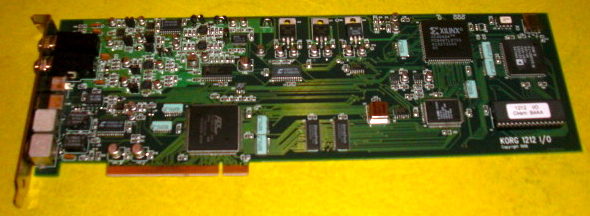That is why I am going to assume another company made the 1212 and Korg marketed it... or maybe, they were just behind in the computer interface market at the time

maybe it was the mac drivers programming/support was just sucky.
u mention asio drivers.. but at time of release, i dont even think ASIO was invented then!!!
(it may or may not have been -
http://comp.ist.utl.pt/ec-ra/Laboratorio/ASIO%20SDK%202.pdf this document states 1997 as the first copyright date for the ASIO sdk API)
remember it was early/mid 1997 that the korg 1212 hit the streets.. a different time..
i was using a Sound Blaster AWE64 gold that i thought was the bomb at the time! on my win95 packard bell pentium system in 1997..

the pentium II had just been released.. and there was no G3 chip yet.. only 600 series PowerPC cpus
im surprised those cpus could handle multitrack ADAT audio at all!!!!!!!!
Are u sure that the "percieved shittyness" didnt have more to do with the fact that people
were running it on such slow cpus?? plus the hard drives of those days were CRAP total crap
even the best SCSI drives were crap really. hard disk recording with that slow cpu / system bus / hard drive speed
must have been a total hit + miss garbage run - barely possible
7.6.1 had just been released in april of 1997 - mac os 8.0 was released soon after
windows 95 + windows NT + mac os 7.61 were very much current OS choices
Cubase Audio XT was probably the place it was used most... running on windows 95
and probably Cubase VST 3.5 on the mac, under 7.61 / 8.0
http://www.soundonsound.com/sos/1997_articles/jul97/korg1212.htmlanother thing to consider is ram.. what was a common RAM size in 1997?
i think it was still between 16-64MB of ram was the max in ANY MACHINE AT THE TIME!!
64 megabytes of ram..

doing ADAT multichannel audio.. it was a miracle the shit even worked! lol
http://redhill.net.au/b/b-97.htmlthis page shows alot of motherboards (pc) that were taking up to 128, 256 + 384 mb of ram, but none higher then that..
and i think prior to 1997.. 64mb was the highest.... which would mean alot of pcs in 1997 would still have had 64mb or less.. unless they had a brand new machine they just shelled out mucho deniro for.
interesting to see ISA architecture still in full swing in 97.. i guess it wasnt untill 1998 or so that it started to go the way of the dodo bird!
heres a page listing all the macs from 1997
http://www.everymac.com/systems/by_year/macs-released-in-1997.htmlthe 9600 was new kid on the block
 http://www.everymac.com/systems/apple/powermac/specs/powermac_9600_350.html
http://www.everymac.com/systems/apple/powermac/specs/powermac_9600_350.htmlcame shipped with only 64MB RAM! + Twin Turbo 128 video pci
(i didnt know that was the oem vidcard on the 9600! interesting)
oops looks like i made a mistake
according to my post
http://www.oldschooldaw.com/forums/index.php?topic=190.0 cubase audio xt didnt support the 1212.. i thought that it did.. my bad


